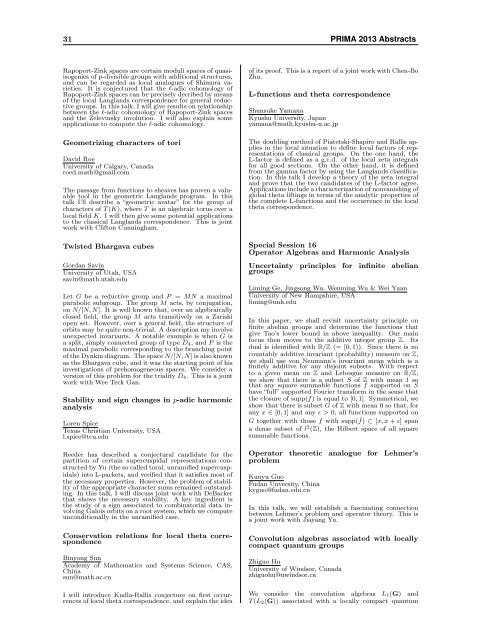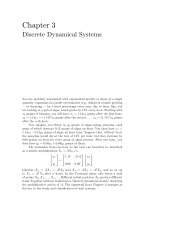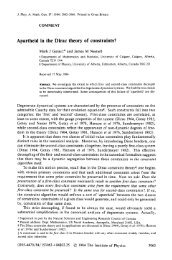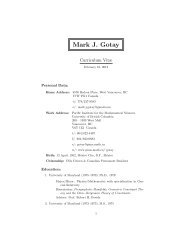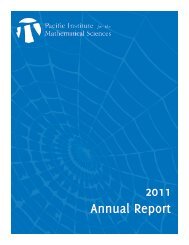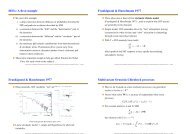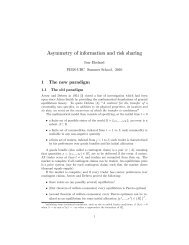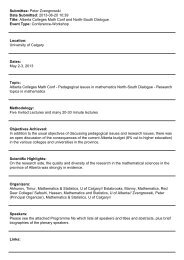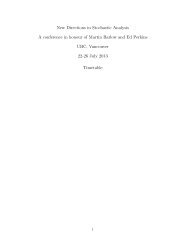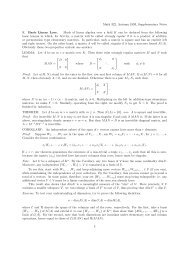31 PRIMA 2013 AbstractsRapoport-Zink spaces are certain moduli spaces of quasiisogeniesof p-divisible groups with additional structures,and can be regarded as local analogues of Shimura varieties.It is conjectured th<strong>at</strong> the l-adic cohomology ofRapoport-Zink spaces can be precisely decribed by meansof the local Langlands correspondence for general reductivegroups. In this talk, I will give results on rel<strong>at</strong>ionshipbetween the l-adic cohomology of Rapoport-Zink spacesand the Zelevinsky involution. I will also explain someapplic<strong>at</strong>ions to compute the l-adic cohomology.Geometrizing characters of toriDavid RoeUniversity of Calgary, Canadaroed.m<strong>at</strong>h@gmail.comThe passage from functions to sheaves has proven a valuabletool in the geometric Langlands program. In thistalk I’ll describe a “geometric av<strong>at</strong>ar” for the group ofcharacters of T (K), where T is an algebraic torus over alocal field K. I will then give some potential applic<strong>at</strong>ionsto the classical Langlands correspondence. This is jointwork with Clifton Cunningham.Twisted Bhargava cubesGordan SavinUniversity of Utah, USAsavin@m<strong>at</strong>h.utah.eduLet G be a reductive group and P = MN a maximalparabolic subgroup. The group M acts, by conjug<strong>at</strong>ion,on N/[N, N]. It is well known th<strong>at</strong>, over an algebraicallyclosed field, the group M acts transitively on a Zariskiopen set. However, over a general field, the structure oforbits may be quite non-trivial. A description my involveunexpected invariants. A notable example is when G isa split, simply connected group of type D 4 , and P is themaximal parabolic corresponding to the branching pointof the Dynkin diagram. The space N/[N, N] is also knownas the Bhargava cube, and it was the starting point of hisinvestig<strong>at</strong>ions of prehomogeneous spaces. We consider aversion of this problem for the triality D 4 . This is a jointwork with Wee Teck Gan.Stability and sign changes in p-adic harmonicanalysisLoren SpiceTexas Christian University, USAl.spice@tcu.eduReeder has described a conjectural candid<strong>at</strong>e for thepartition of certain supercuspidal represent<strong>at</strong>ions constructedby Yu (the so called toral, unramified supercuspidals)into L-packets, and verified th<strong>at</strong> it s<strong>at</strong>isfies most ofthe necessary properties. However, the problem of stabilityof the appropri<strong>at</strong>e character sums remained outstanding.In this talk, I will discuss joint work with DeBackerth<strong>at</strong> shows the necessary stability. A key ingredient isthe study of a sign associ<strong>at</strong>ed to combin<strong>at</strong>orial d<strong>at</strong>a involvingGalois orbits on a root system, which we computeunconditionally in the unramified case.Conserv<strong>at</strong>ion rel<strong>at</strong>ions for local theta correspondenceBinyong SunAcademy of M<strong>at</strong>hem<strong>at</strong>ics and Systems Science, CAS,Chinasun@m<strong>at</strong>h.ac.cnI will introduce Kudla-Rallis conjecture on first occurrencesof local theta correspondence, and explain the ideaof its proof. This is a report of a joint work with Chen-BoZhu.L-functions and theta correspondenceShunsuke YamanaKyushu University, Japanyamana@m<strong>at</strong>h.kyushu-u.ac.jpThe doubling method of Pi<strong>at</strong>etski-Shapiro and Rallis appliesin the local situ<strong>at</strong>ion to define local factors of represent<strong>at</strong>ionsof classical groups. On the one hand, theL-factor is defined as a g.c.d. of the local zeta integralsfor all good sections. On the other hand, it is definedfrom the gamma factor by using the Langlands classific<strong>at</strong>ion.In this talk I develop a theory of the zeta integraland prove th<strong>at</strong> the two candid<strong>at</strong>es of the L-factor agree.Applic<strong>at</strong>ions include a characteriz<strong>at</strong>ion of nonvanishing ofglobal theta liftings in terms of the analytic properties ofthe complete L-functions and the occurrence in the localtheta correspondence.Special Session 16Oper<strong>at</strong>or Algebras and Harmonic AnalysisUncertainty principles for infinite abeliangroupsLiming Ge, Jingsong Wu, Wenming Wu & Wei YuanUniversity of New Hampshire, USAliming@unh.eduIn this paper, we shall revisit uncertainty principle onfinite abelian groups and determine the functions th<strong>at</strong>give Tao’s lower bound in above inequality. Our mainfocus then moves to the additive integer group Z. Itsdual is identified with R/Z (= [0, 1)). Since there is nocountably additive invariant (probability) measure on Z,we shall use von Neumann’s invariant mean which is afinitely additive for any disjoint subsets. With respectto a given mean on Z and Lebesgue measure on R/Z,we show th<strong>at</strong> there is a subset S of Z with mean 1 soth<strong>at</strong> any square summable functions f supported on Shave “full” supported Fourier transform in the sense th<strong>at</strong>the closure of supp(f) is equal to [0, 1]. Symmetrical, weshow th<strong>at</strong> there is subset G of Z with mean 0 so th<strong>at</strong>, forany x ∈ [0, 1] and any ɛ > 0, all functions supported onG together with those f with supp( ˆf) ⊂ [x, x + ɛ] spana dense subset of l 2 (Z), the Hilbert space of all squaresummable functions.Oper<strong>at</strong>or theoretic analogue for Lehmer’sproblemKunyu GuoFudan Unversity, Chinakyguo@fudan.edu.cnIn this talk, we will establish a fascin<strong>at</strong>ing connectionbetween Lehmer’s problem and oper<strong>at</strong>or theory. This isa joint work with Jiayang Yu.Convolution algebras associ<strong>at</strong>ed with locallycompact quantum groupsZhiguo HuUniversity of Windsor, Canadazhiguohu@uwindsor.caWe consider the convolution algebras L 1 (G) andT (L 2 (G)) associ<strong>at</strong>ed with a locally compact quantum
32 PRIMA 2013 Abstractsgroup G, where T (L 2 (G)) is the space of trace class oper<strong>at</strong>orson L 2 (G) with the convolution induced by theright fundamental unitary of G. We obtain a n<strong>at</strong>ural isomorphismbetween the completely bounded right multiplieralgebras of L 1 (G) and T (L 2 (G)), and characterizethe regularity of the quantum group G in terms of theconvolution on T (L 2 (G)). We show th<strong>at</strong> T (L 2 (G)) isstrongly Arens irregular in the sense of Dales and Lauif and only if G is finite. Some commut<strong>at</strong>ion rel<strong>at</strong>ionsof completely bounded multipliers of L 1 (G) will also bediscussed. This is joint work with M<strong>at</strong>thias Neufang andZhong-Jin Ruan.Complex geometry and similarity of Cowen-Douglas oper<strong>at</strong>orsChunlan JiangHebei Normal University, Chinacljiang@hebtu.edu.cnIn this talk, we discuss the similarity invariant of the geometryoper<strong>at</strong>or induced by the holomorphic bundle. Wegive a complete similarity invariant of this kind of geometryoper<strong>at</strong>or by using K-group and curv<strong>at</strong>ure.Minimum phase oper<strong>at</strong>ors and the Polya-Schur problemMichael P. LamoureuxUniversity of Calgary, Canadamikel@ucalgary.caWe set a m<strong>at</strong>hem<strong>at</strong>ical framework for understanding minimumphase preserving physical processes and obtain thefollowing. The n<strong>at</strong>ural analytic setting for these timelimitedsignals is Hilbert-Hardy space. The minimumphase (or impulsive) signals correspond to the outer functionsin Hardy space. The minimum phase preservingprocesses correspond to linear oper<strong>at</strong>ors which preservethe set of shifted outer functions.Our main result shows these linear oper<strong>at</strong>ors on Hardyspace are completely characterized as a combin<strong>at</strong>ion ofa multiplic<strong>at</strong>ion and a composition oper<strong>at</strong>or involvingholomorphic functions of a specific form. The proof ofthis result makes essential use of Hadamard’s Theoremand the Weierstrass product represent<strong>at</strong>ion. Remarkably,this result also extends to provide constructive solutionsto the Polya-Schur problem of finding linear oper<strong>at</strong>orsth<strong>at</strong> preserve the zero-sets of families of complex polynomials.Returning to the physical problem, these processesthus consist of a st<strong>at</strong>ionary filtering combined witha frequency-dependent Q-<strong>at</strong>tenu<strong>at</strong>ion.Joint with Peter. C. Gibson and Gary F. MargraveKishimoto’s conjugacy theorems in simple C ∗ -algebras of tracial rank oneHuaxin LinUniversity of Oregon, USAhlin@uoregon.eduLet A be a unital separable simple amenable C*-algebrawith finite tracial rank which s<strong>at</strong>isfies the UCT. Supposeα and β are two automorphisms with the Rokhlin property.We show th<strong>at</strong> α and β are strongly co-cycle conjug<strong>at</strong>eand uniformly approxim<strong>at</strong>ely conjug<strong>at</strong>e, i.e., thereexists a sequence of unitaries {u n} ⊂ A and a sequence ofstrong asymptotically inner automorphisms σ n such th<strong>at</strong>α = Ad u n ◦ σ n ◦ β ◦ βn −1 and lim ‖un − 1‖ = 0,n→∞provided th<strong>at</strong> they induce the same K-theoretical d<strong>at</strong>a.We also show th<strong>at</strong> converse also holds. We also give aK-description as exactly when α and β are co-cycle conjug<strong>at</strong>e.We also show th<strong>at</strong> given a K-theoretical d<strong>at</strong>a,there is an automorphism α with the Rokhlin propertywhich has th<strong>at</strong> given K-theoretical d<strong>at</strong>a.Spectral gap actions and invariant st<strong>at</strong>esChi-Keung NgNankai University, Chinackng@nankai.edu.cnWe define spectral gap actions of discrete groups on vonNeumann algebras and study their rel<strong>at</strong>ions with invariantst<strong>at</strong>es. We will show th<strong>at</strong> a finitely gener<strong>at</strong>ed ICCgroup Γ is inner amenable if and only if there exist morethan one inner invariant st<strong>at</strong>es on the group von Neumannalgebra L(Γ). Moreover, a countable discrete groupΓ has property (T ) if and only if for any action α of Γ ona von Neumann algebra N, every α-invariant st<strong>at</strong>e on Nis a weak- ∗ -limit of a net of normal α-invariant st<strong>at</strong>es.Quantum correl<strong>at</strong>ions and Tsirelson’s problemNarutaka OzawaKyoto University, Japannarutaka@kurims.kyoto-u.ac.jpThe EPR paradox tells us quantum theory is incomp<strong>at</strong>iblewith classic realistic theory. Indeed, Bell has shownth<strong>at</strong> quantum correl<strong>at</strong>ions of independent bipartite systemshave more possibility than the classical correl<strong>at</strong>ions.To study wh<strong>at</strong> the possibilities are, Tsirelson has introducedthe set of quantum correl<strong>at</strong>ion m<strong>at</strong>rices, but dependingon the interpret<strong>at</strong>ion of independence, there aretwo plausible definitions of it. Tsirelson’s problem askswhether these definitions are equivalent. It turned outth<strong>at</strong> this problem in quantum inform<strong>at</strong>ion theory is infact equivalent to Connes’s embedding conjecture, one ofthe most important open problems in theory of oper<strong>at</strong>oralgebras. I will talk some recent progress on Tsirelson’sproblem.Ergodic theory over locally compact quantumgroupsVolker RundeUniversity of Alberta, Canadavrunde@ualberta.caWe develop the elements of an ergodic theory over locallycompact quantum (semi)groups and extend resultsby Zsidó et al.. This is joint work with Ami Viselter.Extending deriv<strong>at</strong>ions to dual Banach algebrasEbrahim SameiUniversity of Sask<strong>at</strong>chewan, Canadasamei@m<strong>at</strong>h.usask.caIf D : A → X is a deriv<strong>at</strong>ion from a Banach algebra toa contractive, Banach A-bimodule, then one can equipX ∗∗ with an A ∗∗ -bimodule structure, such th<strong>at</strong> the secondtranspose D ∗∗ : A ∗∗ → X ∗∗ is again a deriv<strong>at</strong>ion.I present an analogous extension result, where A ∗∗ is replacedby the enveloping dual Banach algebra F(A) (as introducedby V. Runde), and X ∗∗ by an appropri<strong>at</strong>e kindof universal, enveloping, normal dual bimodule of X. Ourapproach is motiv<strong>at</strong>ed by earlier results of F. Gourdeau.I apply these constructions to obtain some new characteriz<strong>at</strong>ionsof Connes-amenability of F(A). In particular, weshow th<strong>at</strong> F(A) is Connes-amenablity if and only if A admitsa so-called WAP-virtual diagonal. Also, in the casewhere A = L 1 (G), we show by modifying arguments ofRunde th<strong>at</strong> existence of a WAP-virtual diagonal is equivalentto the existence of a virtual diagonal in the usual
- Page 2 and 3:
1PRIMA 2013-Table of ContentsTable
- Page 4 and 5:
3PRIMA 2013-OrganizationOrganizatio
- Page 6 and 7:
5PRIMA 2013-OrganizationYoshikazu G
- Page 8 and 9:
7PRIMA 2013-Useful InformationUsefu
- Page 10 and 11:
9PRIMA 2013-Useful InformationTaxi:
- Page 12 and 13:
11PRIMA 2013-Useful Informationmath
- Page 14 and 15:
13PRIMA 2013 Program-Schedule-at-a-
- Page 16 and 17:
15PRIMA 2013 Program-Monday, June 2
- Page 18 and 19:
17PRIMA 2013 Program-Monday, June 2
- Page 20 and 21:
19PRIMA 2013 Program-Monday, June 2
- Page 22 and 23:
21PRIMA 2013 Program-Monday, June 2
- Page 24 and 25:
23PRIMA 2013 Program-Tuesday, June
- Page 26 and 27:
25PRIMA 2013 Program-Tuesday, June
- Page 29 and 30: 28PRIMA 2013 Program-Tuesday, June
- Page 31 and 32: 30PRIMA 2013 Program-Tuesday, June
- Page 33 and 34: 32PRIMA 2013 Program-Wednesday, Jun
- Page 35 and 36: 34PRIMA 2013 Program- Thursday, Jun
- Page 37 and 38: 36PRIMA 2013 Program- Thursday, Jun
- Page 39 and 40: 38PRIMA 2013 Program- Thursday, Jun
- Page 41 and 42: 40PRIMA 2013 Program- Thursday, Jun
- Page 43 and 44: 42PRIMA 2013 Program- Friday, June
- Page 45 and 46: 44PRIMA 2013 Program- Friday, June
- Page 48 and 49: 1 PRIMA 2013 AbstractsContents1 Pub
- Page 50 and 51: 3 PRIMA 2013 Abstractsof subfactors
- Page 52 and 53: 5 PRIMA 2013 AbstractsprocessesXu S
- Page 54 and 55: 7 PRIMA 2013 AbstractsIn this talk
- Page 56 and 57: 9 PRIMA 2013 Abstractsindependently
- Page 58 and 59: 11 PRIMA 2013 AbstractsEnumerating,
- Page 60 and 61: 13 PRIMA 2013 AbstractsRyuhei Uehar
- Page 62 and 63: 15 PRIMA 2013 AbstractsIn this talk
- Page 64 and 65: 17 PRIMA 2013 AbstractsSpecial Sess
- Page 66 and 67: 19 PRIMA 2013 Abstractscritical slo
- Page 68 and 69: 21 PRIMA 2013 AbstractsSpecial Sess
- Page 70 and 71: 23 PRIMA 2013 Abstractsstrictly awa
- Page 72 and 73: 25 PRIMA 2013 AbstractsPedram Hekma
- Page 74 and 75: 27 PRIMA 2013 Abstractsis well-know
- Page 76 and 77: 29 PRIMA 2013 Abstractssolid substr
- Page 80 and 81: 33 PRIMA 2013 Abstractssense. Our a
- Page 82 and 83: 35 PRIMA 2013 AbstractsIn an econom
- Page 84 and 85: 37 PRIMA 2013 AbstractsKyoto Univer
- Page 86 and 87: 39 PRIMA 2013 AbstractsAlexander Mo
- Page 88 and 89: 41 PRIMA 2013 AbstractsOsamu SaekiK
- Page 90 and 91: 43 PRIMA 2013 Abstractsopen Delzant
- Page 92 and 93: 45 PRIMA 2013 AbstractsJian ZhouTsi
- Page 94 and 95: 47 PRIMA 2013 AbstractsJiaqun WeiNa
- Page 96 and 97: 49 PRIMA 2013 Abstractsthe end of 2
- Page 98 and 99: 51 PRIMA 2013 AbstractsJongyook Par
- Page 100 and 101: 53 PRIMA 2013 AbstractsPancyclicity
- Page 102 and 103: 55 PRIMA 2013 AbstractsEfficient nu
- Page 104 and 105: 57 PRIMA 2013 Abstractsand fountain
- Page 106: 59 PRIMA 2013 Abstractsformula esti


